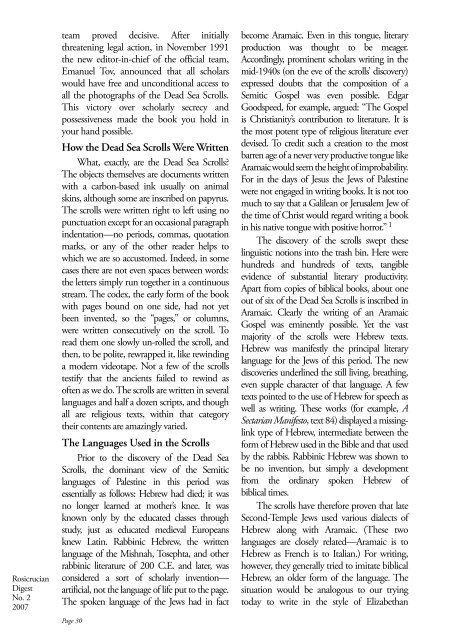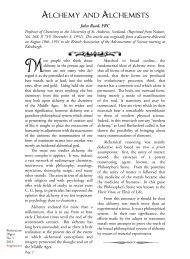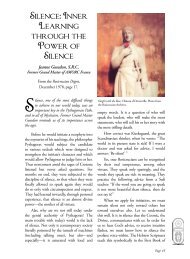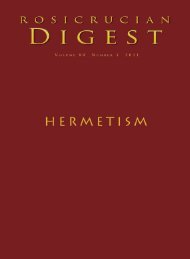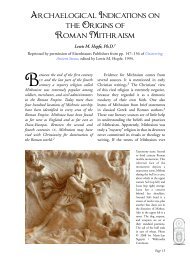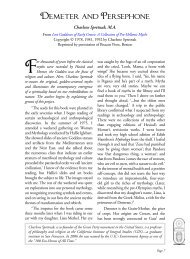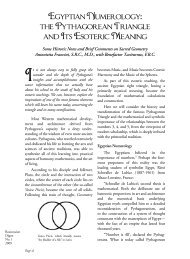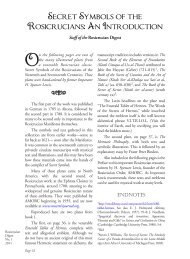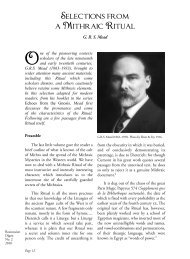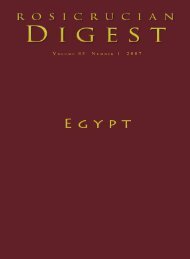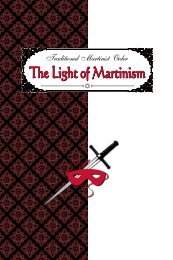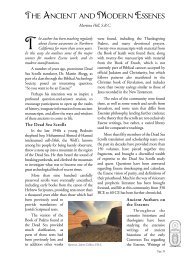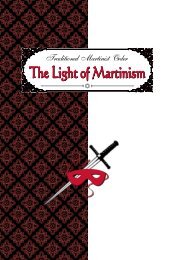Rosicrucian Digest Vol 85 Number 2 2007 - Rosicrucian Order
Rosicrucian Digest Vol 85 Number 2 2007 - Rosicrucian Order
Rosicrucian Digest Vol 85 Number 2 2007 - Rosicrucian Order
Create successful ePaper yourself
Turn your PDF publications into a flip-book with our unique Google optimized e-Paper software.
<strong>Rosicrucian</strong><br />
<strong>Digest</strong><br />
No. 2<br />
<strong>2007</strong><br />
team proved decisive. After initially<br />
threatening legal action, in November 1991<br />
the new editor-in-chief of the official team,<br />
Emanuel Tov, announced that all scholars<br />
would have free and unconditional access to<br />
all the photographs of the Dead Sea Scrolls.<br />
This victory over scholarly secrecy and<br />
possessiveness made the book you hold in<br />
your hand possible.<br />
How the Dead Sea Scrolls Were Written<br />
What, exactly, are the Dead Sea Scrolls?<br />
The objects themselves are documents written<br />
with a carbon-based ink usually on animal<br />
skins, although some are inscribed on papyrus.<br />
The scrolls were written right to left using no<br />
punctuation except for an occasional paragraph<br />
indentation—no periods, commas, quotation<br />
marks, or any of the other reader helps to<br />
which we are so accustomed. Indeed, in some<br />
cases there are not even spaces between words:<br />
the letters simply run together in a continuous<br />
stream. The codex, the early form of the book<br />
with pages bound on one side, had not yet<br />
been invented, so the “pages,” or columns,<br />
were written consecutively on the scroll. To<br />
read them one slowly un-rolled the scroll, and<br />
then, to be polite, rewrapped it, like rewinding<br />
a modern videotape. Not a few of the scrolls<br />
testify that the ancients failed to rewind as<br />
often as we do. The scrolls are written in several<br />
languages and half a dozen scripts, and though<br />
all are religious texts, within that category<br />
their contents are amazingly varied.<br />
The Languages Used in the Scrolls<br />
Prior to the discovery of the Dead Sea<br />
Scrolls, the dominant view of the Semitic<br />
languages of Palestine in this period was<br />
essentially as follows: Hebrew had died; it was<br />
no longer learned at mother’s knee. It was<br />
known only by the educated classes through<br />
study, just as educated medieval Europeans<br />
knew Latin. Rabbinic Hebrew, the written<br />
language of the Mishnah, Tosephta, and other<br />
rabbinic literature of 200 C.E. and later, was<br />
considered a sort of scholarly invention—<br />
artificial, not the language of life put to the page.<br />
The spoken language of the Jews had in fact<br />
Page 30<br />
become Aramaic. Even in this tongue, literary<br />
production was thought to be meager.<br />
Accordingly, prominent scholars writing in the<br />
mid-1940s (on the eve of the scrolls’ discovery)<br />
expressed doubts that the composition of a<br />
Semitic Gospel was even possible. Edgar<br />
Goodspeed, for example, argued: “The Gospel<br />
is Christianity’s contribution to literature. It is<br />
the most potent type of religious literature ever<br />
devised. To credit such a creation to the most<br />
barren age of a never very productive tongue like<br />
Aramaic would seem the height of improbability.<br />
For in the days of Jesus the Jews of Palestine<br />
were not engaged in writing books. It is not too<br />
much to say that a Galilean or Jerusalem Jew of<br />
the time of Christ would regard writing a book<br />
in his native tongue with positive horror.” 1<br />
The discovery of the scrolls swept these<br />
linguistic notions into the trash bin. Here were<br />
hundreds and hundreds of texts, tangible<br />
evidence of substantial literary productivity.<br />
Apart from copies of biblical books, about one<br />
out of six of the Dead Sea Scrolls is inscribed in<br />
Aramaic. Clearly the writing of an Aramaic<br />
Gospel was eminently possible. Yet the vast<br />
majority of the scrolls were Hebrew texts.<br />
Hebrew was manifestly the principal literary<br />
language for the Jews of this period. The new<br />
discoveries underlined the still living, breathing,<br />
even supple character of that language. A few<br />
texts pointed to the use of Hebrew for speech as<br />
well as writing. These works (for example, A<br />
Sectarian Manifesto, text 84) displayed a missinglink<br />
type of Hebrew, intermediate between the<br />
form of Hebrew used in the Bible and that used<br />
by the rabbis. Rabbinic Hebrew was shown to<br />
be no invention, but simply a development<br />
from the ordinary spoken Hebrew of<br />
biblical times.<br />
The scrolls have therefore proven that late<br />
Second-Temple Jews used various dialects of<br />
Hebrew along with Aramaic. (These two<br />
languages are closely related—Aramaic is to<br />
Hebrew as French is to Italian.) For writing,<br />
however, they generally tried to imitate biblical<br />
Hebrew, an older form of the language. The<br />
situation would be analogous to our trying<br />
today to write in the style of Elizabethan


